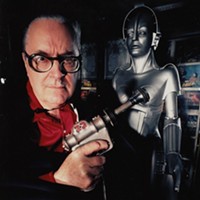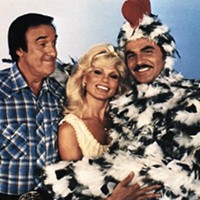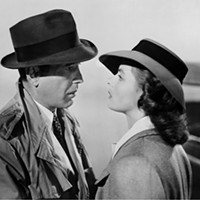After getting the itch to play hooky from life by once again becoming an extra in a Charlotte-area based Hollywood film — I have previously appeared in Shallow Hal, Talladega Nights, Leatherheads and, more recently, the Showtime series Homeland — I got the call from a local casting agent to appear in The Hunger Games.
Huh? The Hunger what?
I had never heard of the book, let alone knew of plans to make a movie from this youth-culture phenomenon. But I would soon learn ...
Wardrobe — July 21, 2011
Arrive at the old Philip Morris plant, three miles north of Charlotte Motor Speedway. Walk upstairs to the holding area where I am measured for costume fitting by a young peroxide blonde wearing a purposely oversized plastic bow in her hair. She advises me that, on the first day of shooting, not to wear any patterned underpants but to bring a couple of extra pairs and socks if it gets too hot.
Given the futuristic look of the movie, am fitted for an over-the-top, high-concept tux: black long coat, cummerbund, pants, purple shirt and purple tie reconfigured to be a cravat. I have been cast as a citizen of The Capital; we are the "haves" as opposed to the "have nots," those who live in "districts" outside the Capital.
Hair is cut by stylist who is proud to point out she worked in Hollywood (many of the behind-the-scenes talent actually come from the Wilmington area). When I get back home, I notice how uneven and altogether unattractive this looks. I head over to Great Clips to undo the do. So much for Hollywood stylists.
Day 1 — Early August
Show up in the new cultural arts district Uptown. Follow the signs to the third floor of the Duke Energy building and head to wardrobe where I am reconnected with my futuristic look. Or, as one of the other extras put it, we all look like we're headed to a Lady Gaga concert.
A couple hundred of us are herded into the Knight Theater auditorium. We are to be the "audience" of a TV show within the narrative of the movie. Eventually, after male and female stand-ins sit for the film crew's efforts to calibrate them for proper light, distance and sound, they are replaced by the actors.
Stanley Tucci takes his place in one of the chairs as the TV show host, to acknowledging applause by us extras.
Tucci's character interviews one of the young female characters in the story. Notwithstanding the repeated takes to redo the scene, the fun for us is in watching Tucci improvise and do shtick with his role as a stereotypically preening, unctuous interviewer. He is genuinely hilarious at times, as he plays with his scripted lines, and we respond "organically." The laughter you will ultimately hear in the movie is authentic response from the "audience' to Tucci's riffs.
During a break, I find myself standing next to the film's director, Gary Ross. I casually remark that, when he gets a chance, he should "tell Tucci there's someone in the audience who used to live in his apartment building." (A technicality — I grew up in and then left that Manhattan Upper West Side building long before it went condo and Tucci moved in.)
Ross dismissively grunt-laughs, and then walks away.
Day 2
The night before, I get a call from one of the AD's [assistant director], who says we are going to do some night shooting. I say, haven't we already gone from day into night? He says "night shooting" is you begin at night and finish the next morning ...
I arrive back at the Philip Morris plant, where one of the mammoth, hangar-sized warehouses has been converted to wardrobe, hair, makeup and holding for us.
However, the wait to go on set — this time, on a section of the campus converted into an outdoor arena — seems interminable. I had arrived at my appointed time of 5:30 p.m. But it's now 10 minutes past midnight. Finally, we are told to walk outside to custom-constructed bleachers and take seats.
The AD tells us that we are there to cheer "wildly, lustfully" for our favorite "tributes" who parade by on horse-drawn chariots. But the cheering and hand-clapping is to be mimed, because the horses are easily "spooked." There's even a wrangler nearby to watch over their handling.
During a break, star Jennifer Lawrence suddenly gets off her chariot and runs at sprinter speed toward the holding area. About six minutes later, she jogs back to mock applause and a nod from us extras, who suspect that, yes, even starlets may suddenly have to heed the call of nature.
At 4:45 a.m., it starts to rain, and we retreat to the warehouse. This cuts short the shoot and everyone stands in long lines as the men and women, respectively, return hairpieces and false eyelashes to props and then continue on to Wardrobe to change back to civvies.
Day 3
Arrived again at 5 p.m. for another night shoot and, again, we wait and wait and wait.
At 2:30 a.m., we're called outside once again to the ersatz bleachers. The parade of the Hunger Games contestants is resumed. Subsequent takes have us mime-cheering in all kinds of permutations — sitting, standing, pointing, first women, then men.
At 5:40 a.m., it's "a wrap."
Day 4
Have I mentioned the equipment? Green screens the size of Jumbotrons to simulate larger background crowds, lights with a brilliance that can probably be seen from the space station, cameras on telescoped cranes that can extend from a stage clear across to practically the back row of the lower level seating. And crews to build TV studios and parade grounds and battle scenes. And caterers, of course, to supply the food.
Hollywood is indeed an "industry."
At around 3 a.m., we board buses and are taken to another facility on the sprawling campus. There, one group of us will take part in a "cafe" scene and the others will see action at a "train station."
My group takes part in the latter, where we take our places on a "platform" and are instructed to hurriedly rush to the edge to fanatically welcome the incoming "train" carrying the young tributes. This exercise tests our powers of imagination, because there is nothing there — just empty space, presumably to be filled in by the technological magic of the green screen.
The end of this shoot, now at daybreak, turns out to be the end of my time with The Hunger Games.
I get in the car and drive the 45-minute route back home. I'm somewhat saddened at the conclusion of my involvement with the making of this movie, but quite content with the experience and unique memories that few people — certainly fewer people still, outside of Hollywood — get to have.
And all at $7.25 per hour, $10.88 overtime.





